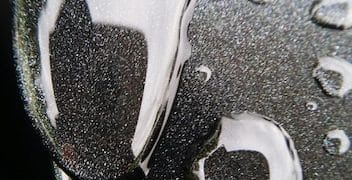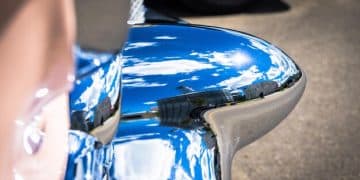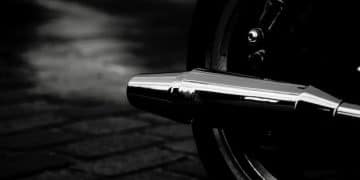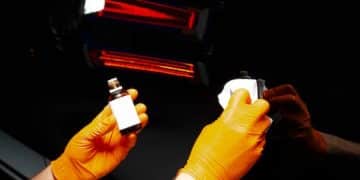New Ceramic Coating: The Ultimate Guide to Car Paint Prep for 3+ Years of Protection
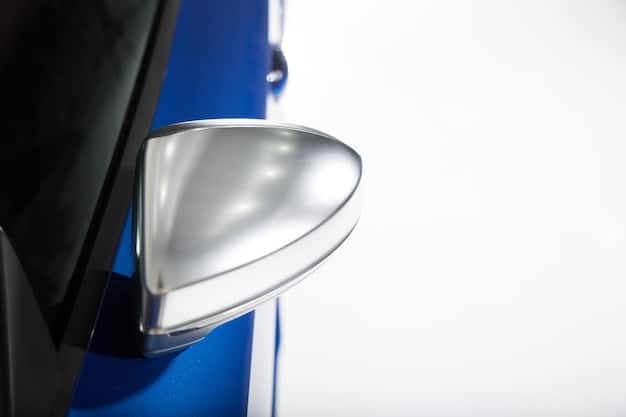
New ceramic coatings offer long-lasting protection for your car’s paint, enhancing its shine and resilience against environmental damage; however, proper preparation is crucial to ensure the coating adheres correctly and provides optimal results, lasting for three or more years.
Thinking about giving your car’s paint some serious, long-lasting protection? A **new ceramic coating** might be just what you need. But before you jump in, it’s absolutely essential to get the paint properly prepped. This isn’t just a quick wash; it’s about setting the stage for the coating to bond perfectly and keep your car looking its best for three years or more.
Why Preparing Your Car’s Paint is Crucial Before a New Ceramic Coating
Getting your car’s paint ready for a ceramic coating isn’t just an extra step; it’s the key to making sure the coating does its job properly. Without thorough preparation, you might as well be throwing money away. The coating needs a clean, smooth surface to stick to, and anything less will compromise its performance.
Think of your car’s paint as a canvas. Before an artist starts painting, they prime the canvas to create a smooth, even surface. Preparing your car’s paint is the same idea. It ensures the ceramic coating bonds correctly and provides the best possible protection and shine.
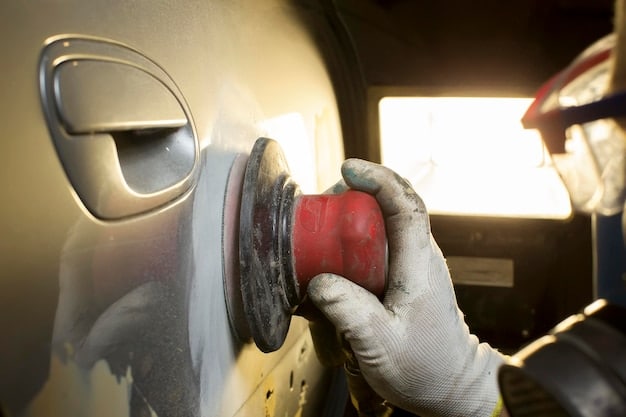
The Importance of a Clean Surface
One of the biggest reasons to prep your car’s paint is to remove any dirt, grime, or contaminants that might be lurking on the surface. These can prevent the ceramic coating from bonding properly, leading to premature failure and a less-than-perfect finish.
Removing Imperfections for a Flawless Finish
Paint correction is another crucial aspect of preparation. This involves removing swirl marks, scratches, and other imperfections from the paint. A smooth, flawless surface will not only look better but also allow the ceramic coating to bond more effectively and provide a deeper, glossier shine.
- Ensures proper bonding of the ceramic coating.
- Maximizes the coating’s protective properties.
- Enhances the overall appearance of the vehicle.
- Prevents premature coating failure and extends its lifespan.
In summary, taking the time to properly prepare your car’s paint is an investment that pays off in the long run. It ensures the ceramic coating performs as intended, providing years of protection and a stunning shine.
Step-by-Step Guide to Preparing Your Car’s Paint
Now that you understand why preparation is so important, let’s dive into the step-by-step process. This guide will walk you through each stage, from washing and decontaminating to polishing and final inspection, ensuring your car’s paint is perfectly ready for a new ceramic coating.
Follow each step carefully, and don’t rush the process. The more attention you pay to detail, the better the final results will be. Remember, the goal is to create a flawless surface that allows the ceramic coating to bond properly and provide long-lasting protection.
Washing: The First Line of Defense
Start by giving your car a thorough wash to remove loose dirt and grime. Use a pH-neutral car wash soap and a microfiber wash mitt to avoid scratching the paint. Rinse thoroughly with clean water.
Decontamination: Removing Embedded Contaminants
Next, use a clay bar or clay mitt to remove any embedded contaminants, such as brake dust, tree sap, or industrial fallout. These contaminants can’t be removed by washing alone and can interfere with the coating’s bonding process.
- Use a pH-neutral car wash soap and a microfiber wash mitt.
- Rinse thoroughly with clean water.
- Use a clay bar or clay mitt to remove embedded contaminants.
- Inspect the paint for any remaining imperfections.
By following these steps, you’ll ensure your car’s paint is clean and free of contaminants, setting the stage for the next crucial phase: paint correction.
Paint Correction: Eliminating Swirl Marks and Scratches
Paint correction is perhaps the most time-consuming but also the most rewarding step in the preparation process. This involves using a machine polisher to remove swirl marks, scratches, and other imperfections from the paint.
If you’re not comfortable using a machine polisher, it’s best to leave this step to a professional. Incorrect polishing can actually damage the paint, making the situation worse. However, with the right tools and techniques, you can achieve stunning results.
Choosing the Right Polishing Pads and Compounds
Select the appropriate polishing pads and compounds based on the severity of the imperfections. Start with a less aggressive pad and compound and gradually increase aggressiveness as needed. Always test a small area first to ensure you’re not causing any damage.
The Polishing Process
Apply the polishing compound to the pad and work it into the paint in overlapping passes. Use a consistent speed and pressure, and avoid staying in one spot for too long. After polishing, wipe the area clean with a microfiber towel.
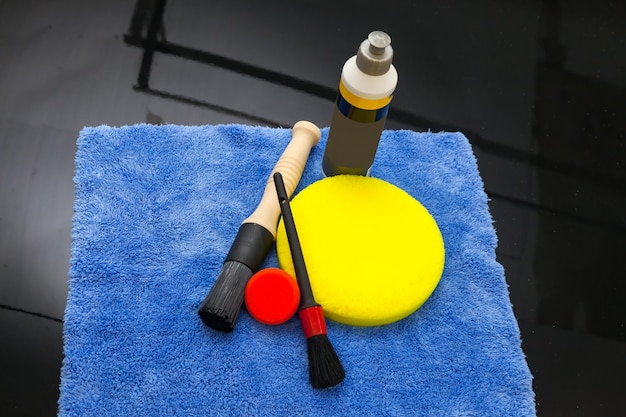
- Choose the right polishing pads and compounds.
- Apply the polishing compound to the pad.
- Work the compound into the paint in overlapping passes.
- Wipe the area clean with a microfiber towel.
Paint correction is a crucial step in preparing your car’s paint for a ceramic coating. It ensures a flawless surface that allows the coating to bond properly and provide a deeper, glossier shine.
Final Inspection and Cleaning: The Last Details Matter
After polishing, it’s time for a final inspection and cleaning. This involves carefully examining the paint for any remaining imperfections and removing any polishing residue. The goal is to create a perfectly clean and smooth surface that’s ready for the ceramic coating.
Don’t skip this step, as even small imperfections or residue can affect the coating’s bonding process and overall appearance. Take your time and pay attention to detail, ensuring every inch of the paint is perfectly clean and smooth.
Using an IPA Wipe-Down
An IPA (isopropyl alcohol) wipe-down is essential to remove any remaining polishing oils or residue. Mix IPA with distilled water in a 1:1 ratio and spray it onto the paint. Wipe the area clean with a microfiber towel.
Looking for Remaining Imperfections
Use a bright light to inspect the paint for any swirl marks, scratches, or other imperfections that may have been missed during the polishing process. If you find any, repeat the polishing process as needed.
- Use an IPA (isopropyl alcohol) wipe-down to remove polishing oils.
- Inspect the paint for any remaining imperfections.
- Ensure the surface is completely clean and smooth.
- Prepare your workspace for the ceramic coating application.
By following these final inspection and cleaning steps, you’ll ensure your car’s paint is perfectly prepared for the ceramic coating, setting the stage for long-lasting protection and a stunning shine.
Applying the New Ceramic Coating: Ensuring Long-Lasting Protection
With your car’s paint now perfectly prepared, it’s time to apply the new ceramic coating. This is the final step in the process, and it’s crucial to follow the manufacturer’s instructions carefully. Applying the coating correctly will ensure it bonds properly and provides long-lasting protection.
Before you start, make sure you have all the necessary tools and materials, including the ceramic coating, applicator pads, and microfiber towels. Wear gloves to protect your hands, and work in a well-ventilated area.
Following Manufacturer’s Instructions
Read the manufacturer’s instructions carefully before applying the ceramic coating. Each product may have slightly different application requirements, so it’s important to understand the specific instructions for your chosen coating.
The Application Process
Apply a small amount of the ceramic coating to the applicator pad and work it into the paint in overlapping passes. Apply even pressure and avoid applying too much product at once. Allow the coating to cure for the recommended time, then buff off any excess with a microfiber towel.
- Read the manufacturer’s instructions carefully.
- Apply a small amount of ceramic coating to the applicator pad.
- Work the coating into the paint in overlapping passes.
- Allow the coating to cure, then buff off any excess.
By following these steps and paying attention to detail, you can successfully apply a new ceramic coating to your car, providing years of protection and a stunning shine.
Maintaining Your Ceramic Coating: Prolonging Its Lifespan
Once you’ve applied the ceramic coating, it’s important to maintain it properly to prolong its lifespan and keep your car looking its best. Regular washing and proper care will help prevent the buildup of dirt and grime, ensuring the coating continues to perform as intended.
Avoid using harsh chemicals or abrasive cleaning products, as these can damage the coating and reduce its effectiveness. Instead, use a pH-neutral car wash soap and a microfiber wash mitt to gently clean the surface.
Regular Washing and Drying Techniques
Wash your car regularly, ideally every two weeks, to remove dirt and grime. Use a gentle, pH-neutral car wash soap and a microfiber wash mitt. Rinse thoroughly with clean water, and dry with a microfiber towel to prevent water spots.
Avoiding Harsh Chemicals and Abrasive Products
Avoid using harsh chemicals, such as degreasers or solvent-based cleaners, as these can damage the ceramic coating. Also, avoid using abrasive cleaning products, such as scouring pads or harsh scrubbing brushes, as these can scratch the coating.
- Wash your car regularly with a pH-neutral soap.
- Dry with a microfiber towel to prevent water spots.
- Avoid harsh chemicals and abrasive products.
- Consider using a ceramic coating maintenance spray.
By following these maintenance tips, you can prolong the lifespan of your ceramic coating and keep your car looking its best for years to come.
| Key Point | Brief Description |
|---|---|
| 🧼 Washing | Removes loose dirt and grime using pH-neutral soap. |
| Claying | Decontaminates by removing embedded particles. |
| ✨ Polishing | Corrects paint by eliminating swirls and scratches. |
| 🛡️ Coating | Applies ceramic for lasting protection after surface is prepped. |
Frequently Asked Questions
▼
Paint correction removes imperfections, such as swirl marks and scratches, providing a smooth surface for the ceramic coating. This ensures optimal bonding and enhances the coating’s appearance and longevity.
▼
It’s recommended to wash your car every two weeks, or as needed, using a pH-neutral car wash soap. Regular washing prevents dirt and grime buildup, maintaining the coating’s effectiveness and shine.
▼
While DIY ceramic coating kits are available, professional application is often recommended for optimal results. Professionals have the expertise and tools to ensure proper preparation and application, maximizing the coating’s benefits.
▼
Avoid harsh chemicals, abrasive cleaning products, and automatic car washes with harsh brushes. These can damage the ceramic coating, reducing its protective properties and lifespan. Always use gentle, pH-neutral products.
▼
A well-maintained ceramic coating can last for several years, often three or more. The longevity depends on the quality of the coating, the application process, and the care taken during maintenance.
Conclusion
Properly preparing your car’s paint before applying a new ceramic coating is essential for achieving the best possible results. By following these steps, you’ll ensure the coating bonds correctly, providing long-lasting protection and a stunning shine that keeps your car looking its best for years.
